Happy to be part of the global ecology starter pack!
go.bsky.app/F86HYqj
29.05.2025 09:03 — 👍 1 🔁 0 💬 0 📌 0
We believe that our framework will enable the systematic study of how landscape structure shapes the dynamics of interacting ecological niches - a crucial point, because a sufficient level of landscape heterogeneity is essential for sustaining biodiversity in spatially extended ecosystems
9/9
16.03.2025 10:41 — 👍 0 🔁 0 💬 1 📌 0
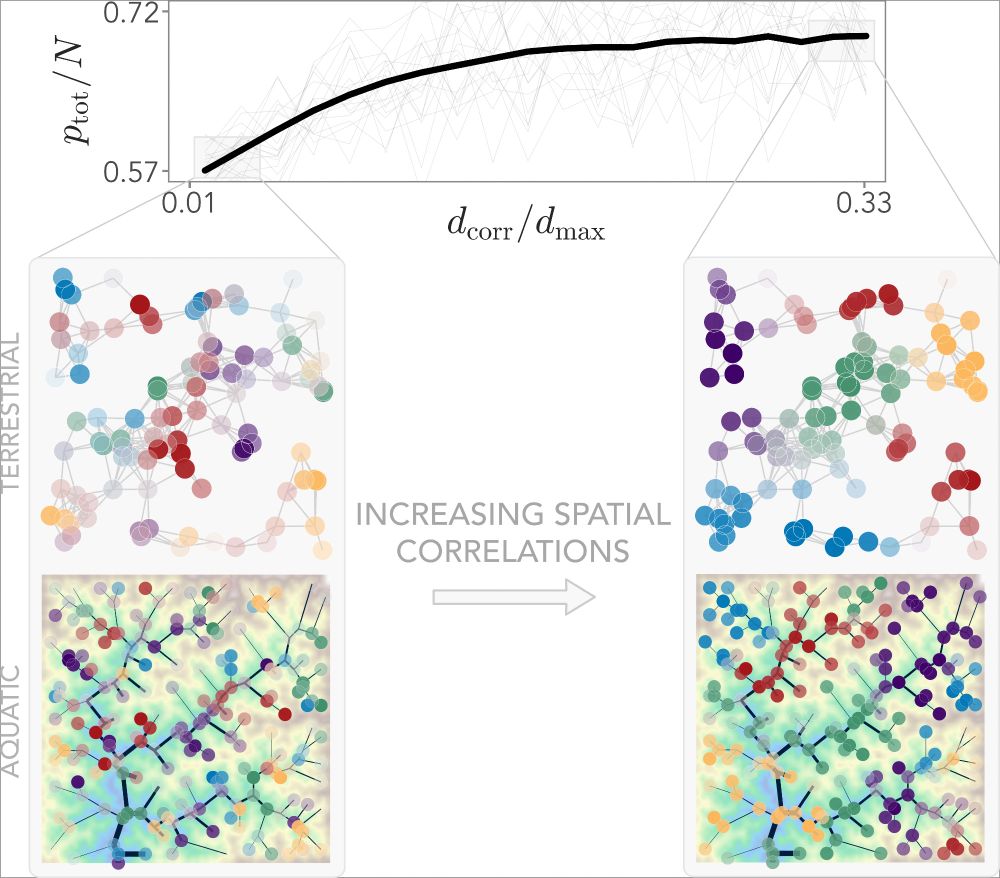
Finally, we connect landscape and habitat heterogeneity by introducing spatial correlation between nearby habitats, using models of aquatic and terrestrial landscapes. Correlations increase the total population and strengthen the buffering effect due to the spatial clustering of niches
8/9
16.03.2025 10:41 — 👍 0 🔁 0 💬 1 📌 0
What is going on? The crucial idea is that the spatial structure helps to buffer competition, increasing diversity and population - species that thrive in one landscape may go extinct in another. Hence, species coexistence is fundamentally entangled with the spatial structure of the ecosystem
7/9
16.03.2025 10:41 — 👍 0 🔁 0 💬 1 📌 0
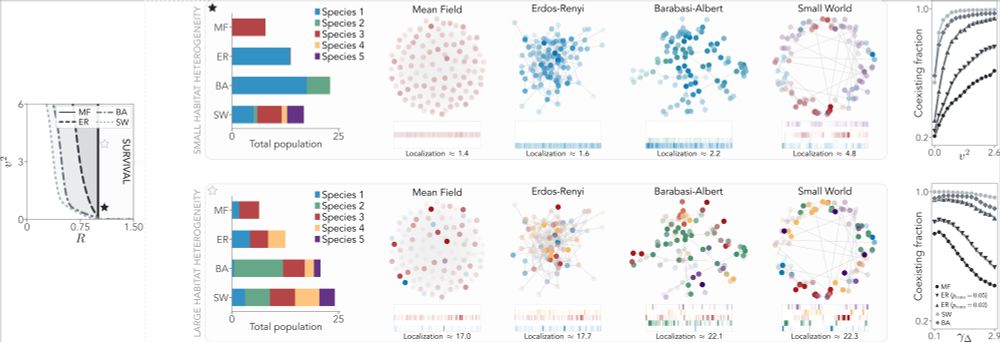
Then, we add landscape heterogeneity by introducing complex dispersal networks! We find that the fraction of coexisting species increases with habitat heterogeneity, and at the same time landscape heterogeneity allows for more species to coexist while increasing the total population
6/9
16.03.2025 10:41 — 👍 0 🔁 0 💬 1 📌 0

We first study a "mean-field case" where all habitat patches are connected to focus on the effect of habitat heterogeneity alone. If it's large enough, coexistence of all species becomes possible thanks to the emergence of ecological niches in different habitats - species start to "localize"
5/9
16.03.2025 10:41 — 👍 0 🔁 0 💬 1 📌 0
And this is where we use the physics of disordered systems! We obtain exact results for an ecosystem where the landscape-mediated fitness is random and follows a generic probability distribution: a spatially disordered landscape where we can tune its spatial heterogeneity and see its effects
4/9
16.03.2025 10:41 — 👍 0 🔁 0 💬 1 📌 0

To quantify habitat heterogeneity, we measure the balance between colonization and extinction via a local “landscape-mediated fitness”: species with large colonization and low extinction rates in a patch have high fitness, and vice-versa. This is akin to the classical metapopulation capacity
3/9
16.03.2025 10:41 — 👍 0 🔁 0 💬 1 📌 0
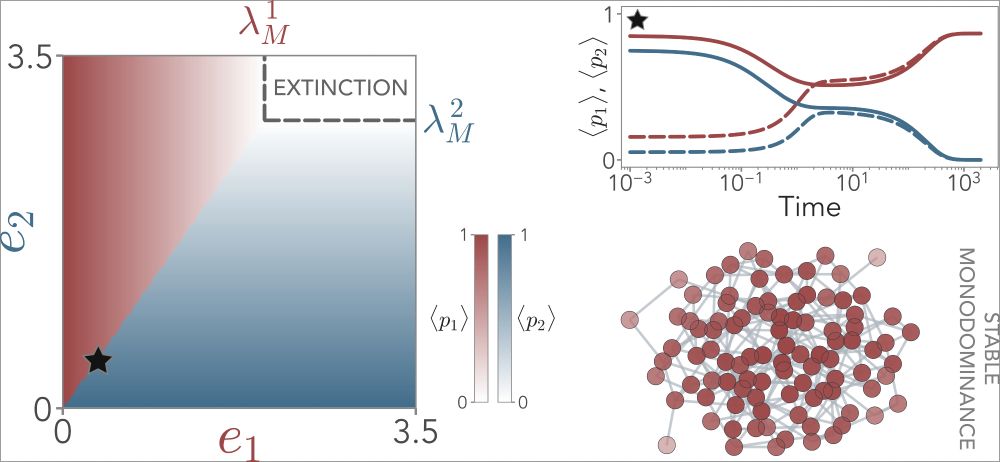
Without heterogeneity, when all habitats are equivalent, we find that the only possible solution is monodominance - the fittest species overtakes the entire ecosystem, regardless of the underlying dispersal network! But what happens if not all habitats are equally good for different species?
2/9
16.03.2025 10:41 — 👍 0 🔁 0 💬 1 📌 0
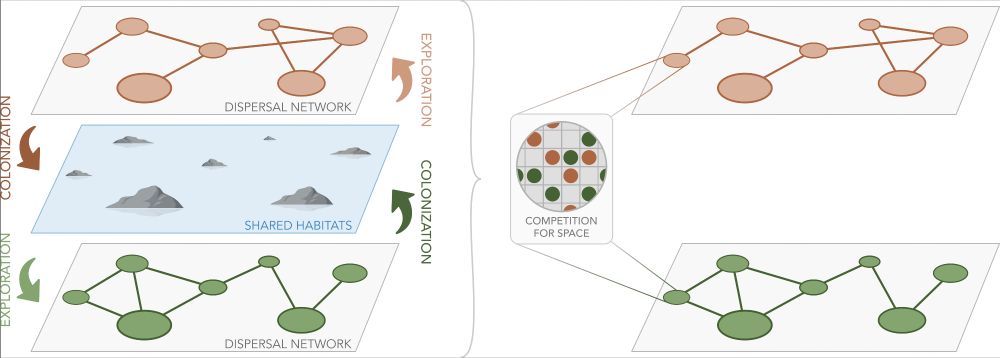
We start by generalizing the seminal metapopulation model by Hanski and Ovaskainen. Species explore and settle on a complex landscape described by a network of habitat patches. Each habitat has a finite amount of colonizable space, generating an effective competition term between species
1/9
16.03.2025 10:41 — 👍 0 🔁 0 💬 1 📌 0

Take-at-home message: we study a general model of spatially extended ecosystems where species compete for spaces in different habitat patches. We find that spatial heterogeneity is the key mechanism allowing the coexistence of a large number of species, and fosters the emergence of ecological niches
16.03.2025 10:41 — 👍 0 🔁 0 💬 1 📌 0
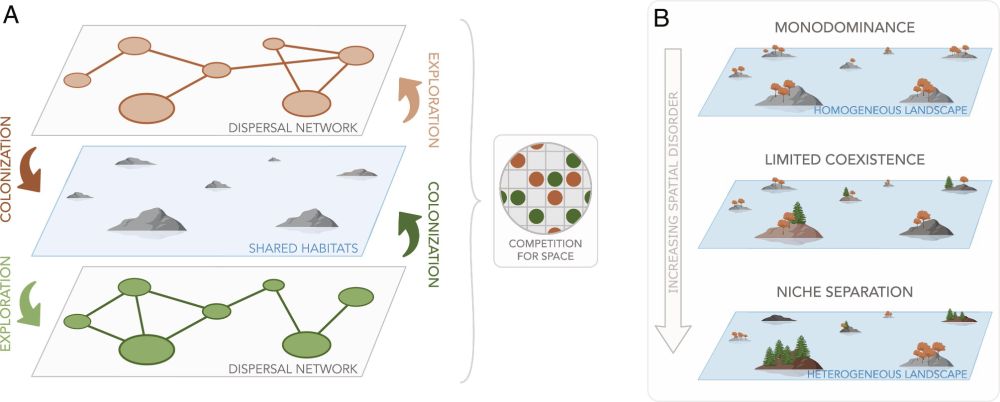
Landscape and environmental heterogeneity support coexistence in competitive metacommunities | PNAS
Metapopulation models have been instrumental in quantifying the ecological impact
of landscape structure on the survival of a focal species. Howeve...
Better late than never: it's time to tell you about my main project at EPFL 🇨🇭! What happens in competitive metacommunities when you take into account spatial structure and habitat heterogeneity? Once more, a great collaboration with @lambdapp and the people at @liphlab!
www.pnas.org/doi/abs/10.1...
16.03.2025 10:41 — 👍 6 🔁 2 💬 1 📌 0
🚀 New research alert! 🚀
Led by @gbarzon.bsky.social, @giorgionicoletti.bsky.social and Daniel Maria Busiello, our latest work in Physical Review Letters (journals.aps.org/prl/abstract...) reveals how excitation-inhibition balance tunes the timescale of information coding in neuronal populations! 🧠🔬
10.03.2025 14:40 — 👍 5 🔁 3 💬 0 📌 0
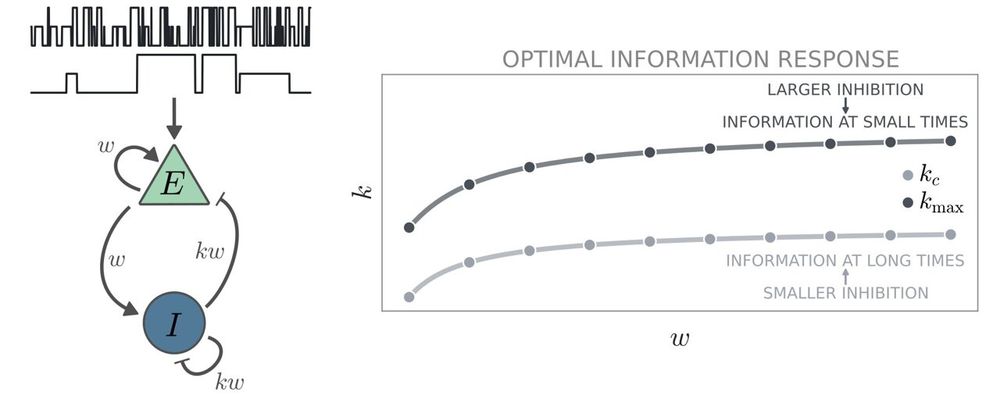
Optimal brain processing requires balance between excitatory and inhibitory neurons, study suggests
The brain's ability to process information is known to be supported by intricate connections between different neuron populations.
Balanced excitatory and inhibitory neuron activity is crucial for optimal brain information processing, highlighting the importance of neural network stability in encoding external signals effectively. doi.org/g87h5w
09.03.2025 09:32 — 👍 6 🔁 3 💬 0 📌 1
And finally a bonus for reading the whole thread: another cool video of metapop dynamics using a DEM from the Himalayas!
10.02.2025 09:33 — 👍 0 🔁 0 💬 0 📌 0
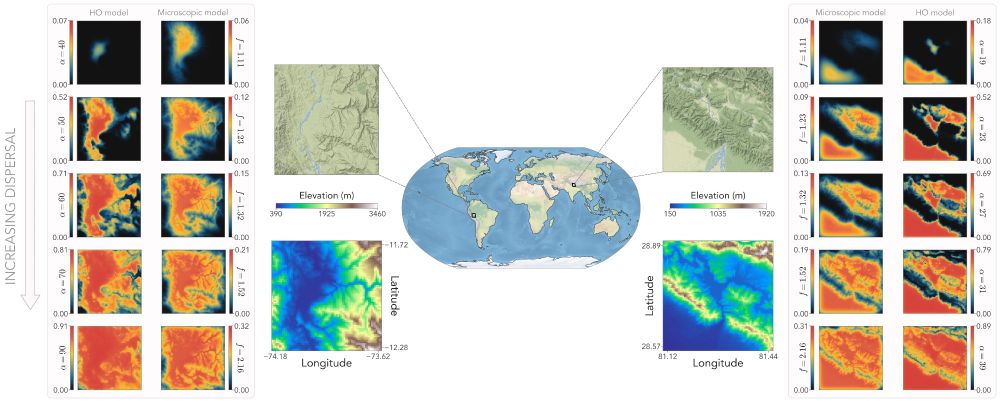
A cool application is elevation-based networks obtained from Digital Elevation Maps (DEMs). By imposing that exploring uphill is harder than downward one, our model captures the dendritic features of complex topographic landscapes
9/9
10.02.2025 09:33 — 👍 0 🔁 0 💬 1 📌 0
Overall, our approach is highly interpretable and extremely flexible, allowing for changes in both the local node dynamics and the exploration ones. Not only that: it works for directed networks as well!
8/9
10.02.2025 09:33 — 👍 0 🔁 0 💬 1 📌 0
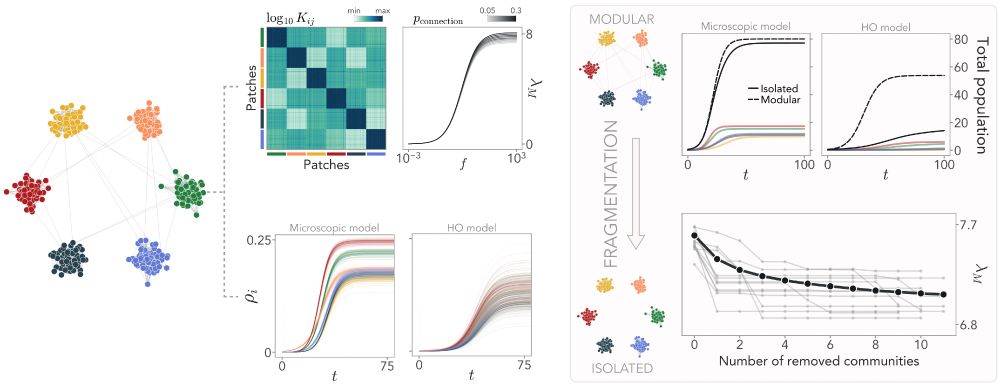
We can study network fragmentation, showing that our model perfectly captures segregation in modular networks and the detrimental effects of landscape fragmentation. Further, we can prove analytically that survival is generally favored in more dense network
7/9
10.02.2025 09:33 — 👍 0 🔁 0 💬 1 📌 0
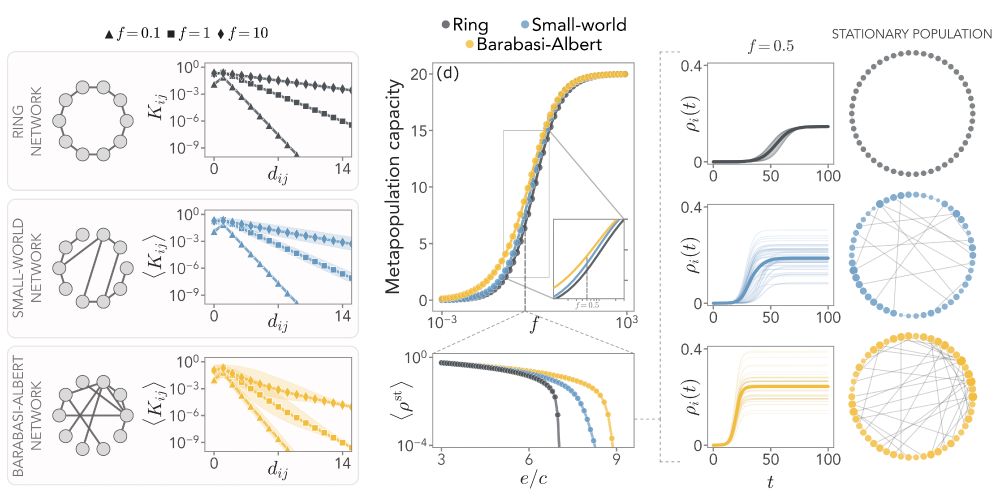
And of course, network topology influences everything - in particular, the survival of the population, quantified by the metapopulation capacity. We find that multiple short paths and hubs in general favor survival and strong localization of the surviving individuals
6/9
10.02.2025 09:33 — 👍 0 🔁 0 💬 1 📌 0

The topological contribution of the underlying networks is naturally encoded in the metapopulation kernel, depending on the species' dispersal. Our model can reproduce classical exponential distance-based kernels, but can capture much more complex network structures
5/9
10.02.2025 09:33 — 👍 0 🔁 0 💬 1 📌 0
But where did the topology go? Our model features an exact all-to-all kernel that quantifies the influence of one node to the other - and it does so by naturally taking into account all possible paths the explorers may have taken to move between the two nodes!
4/9
10.02.2025 09:33 — 👍 0 🔁 0 💬 1 📌 0

With the core assumption that network exploration is faster than the local dynamics, we obtain an effective fully-connected model for the local population - the metapopulation - which is identical in form to classical metapop models such as the Hanski and Ovaskainen's one
3/9
10.02.2025 09:33 — 👍 0 🔁 0 💬 1 📌 0
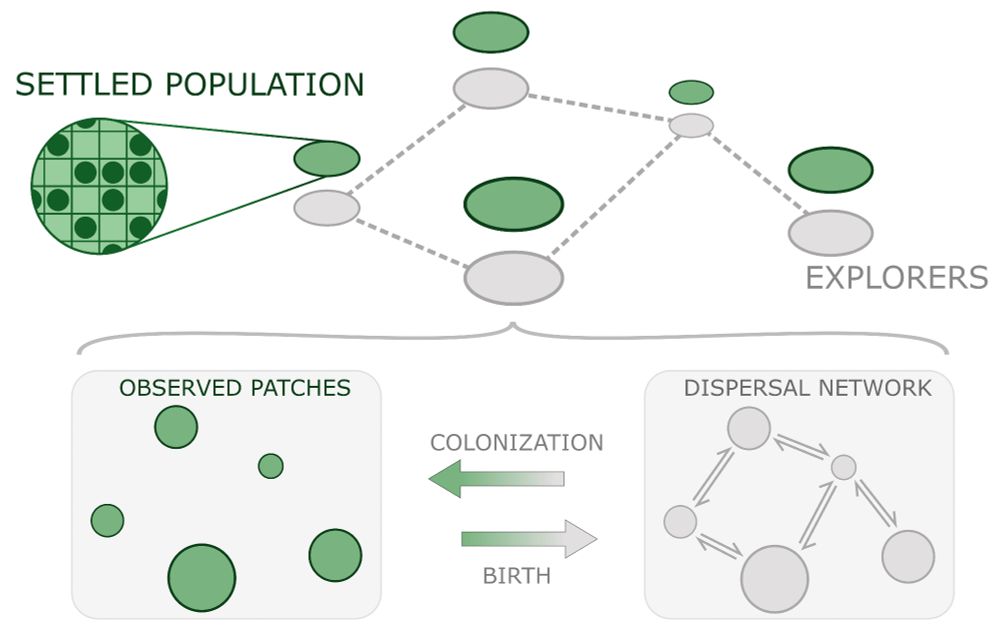
We attempt to answer this question with ecology in mind. We start from a microscopic model of metapopulation dynamics and make the distinction between
👉 a local settled population on nodes
👉 explorers moving around and colonizing empty sites
2/9
10.02.2025 09:33 — 👍 0 🔁 0 💬 1 📌 0
Phenomenological metapop models have proven to be very successful - from predicting species survival in complex landscapes to epidemic spreading in contact networks and urban mobility patterns. But what happens to metapopulation dynamics in arbitrary network topologies?
1/9
10.02.2025 09:33 — 👍 0 🔁 0 💬 1 📌 0
Our model can be applied to any network, including elevation-based ones obtained from DEMs, allowing us to study ecological patterns in real-world scenarios (and make cool videos). Keep reading for all the details!
10.02.2025 09:33 — 👍 0 🔁 0 💬 1 📌 0
Take-at-home message: we derive a general metapop model from interpretable, agent-based dynamics on any network topology. The properties of metapopulation are encoded in an effective kernel that incorporates both the microscopic dynamics and the network structure at once!
10.02.2025 09:33 — 👍 1 🔁 0 💬 1 📌 0
Computational neuroscientist || Postdoc with Tim Behrens || Sainsbury Wellcome Centre @ UCL
Assistant Professor @ucsantabarbara Global Change Forest Ecologist @switzernetwork @SmithFellows @PeaceCorps #BLM
PhD Candidate studying nonequilibrium statistical physics @Univeristy of Augsburg
shape-shifting scholar doing cryptid science. interdependent sociality + brain networks + systems thinking + mental health.
postdoc @ the Network Science Institute, Northeastern University London. 🌈
h-merritt.github.io
Sensory perception, circuits, and behavior | 🇲🇽 | postdoc in the Otopalik & Reiser labs @HHMIJanelia
Theoretical & computational biophysics. Molecular information transfer in the cell. In-cell signaling, protein, membrane & lipid dynamics. Complex environments.
Lab @UIUC: pogorelov.scs.illinois.edu
@insect-vision.bsky.social
Uni Konstanz PhD student with the International Max Planck Research School (QBEE) 🦋🧠🛩️ Intrigued by the algorithms underlying invertebrate sensorimotor control/active sensing, computational ethology, and cool animals 🏳️🌈🇨🇦
Evolutionary biologist @KU_Leuven. #Adaptation #Plasticity #Speciation #Genomics #Beetles #Butterflies #Daphnia.
https://bio.kuleuven.be/eeb/sv/
Studying why and how behavior evolves, from mosquitoes to mole-rats | Postdoc/Leon Levy Scholar @Columbia working with Ishmail Abdus-Saboor | PhD @Princeton with Lindy McBride | 麻布/東大 alum 🇯🇵 | yukihaba.github.io
Assistant Professor at the Department of Computer Science, University of Liverpool.
https://lutzoe.github.io/
Earth resilience, tipping behavior, nonlinear thinking, stability analysis, climate change, photosynthesis, soil respiration, tree mortality, Fulbright Scholar
Lecturer at YNU
Biodiversity Science | Macroecology | Nature's contributions to people | Diverse Values of Nature | Cultural Diversity
Posts are my own.
Exploring complex marine biological systems through math, models, and lab experiments | Postdoc @ MPI & MARUM Bremen | Marine biologist turned interdisciplinary scientist
Publisher at IOP Publishing (Classical and Quantum Gravity, Journal of Physics B: Atomic, Molecular and Optical Physics, Journal of Physics: Complexity)
We work on planetary problems. Currently: counting climate change-related deaths; pandemic risk assessment in a changing biosphere; data, science, and vaccine access during public health emergencies. 👉 carlsonlab.bio
Ecology and evolution of plant-microbe symbiosis. Mapping mycorrhizal diversity and carbon 🏳️🌈
PhD Candidate – Vrije Universiteit Amsterdam
Data Scientist – Society for the Protection of Underground Networks
Professor of Marine Ecology @University of the Aegean. Focus: marine conservation, biological invasions, marine biodiversity, and ecological monitoring. #GuardIAS #MarinePlan #GES4SEAS #NemoTools #BioBoost+ #CamBioMed #INSPIRE #MarineEcology #BioInvasions
Evolutionary ecologist, career break, career change, mentoring, fertility, insects, climate change, Women in STEM, @EvolEcolLincoln. Associate editor @Methodsinecolevol, BiologyLetters. Views my own
Biochemist 🧪| Empowering Life Scientists and Science Communicators to Achieve Their Career Goals | UCLA PhD + NIH Alum | Pharma R&D @GSK + @AstraZeneca 💊 | #SciComm Director ✍️| Career Coach | Star Trek | Sherlock Holmes | 🎹 | https://larrymillerphd.com
Postdoctoral Researcher at Cornell and with the Tawaki Trust. Seabird foraging ecology. Stable isotopes. Diving physiology. Population dynamics. he/him 🏳️🌈 #firstgen
















